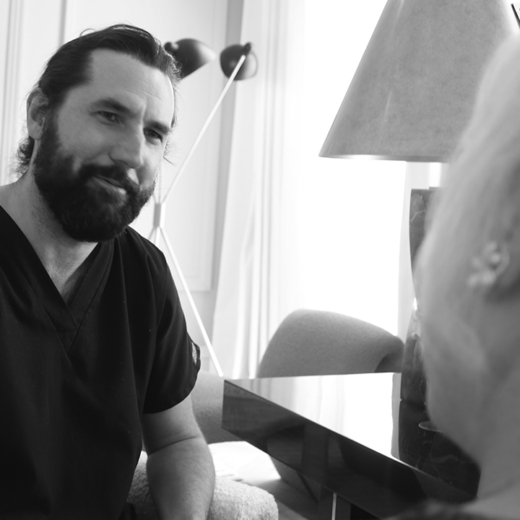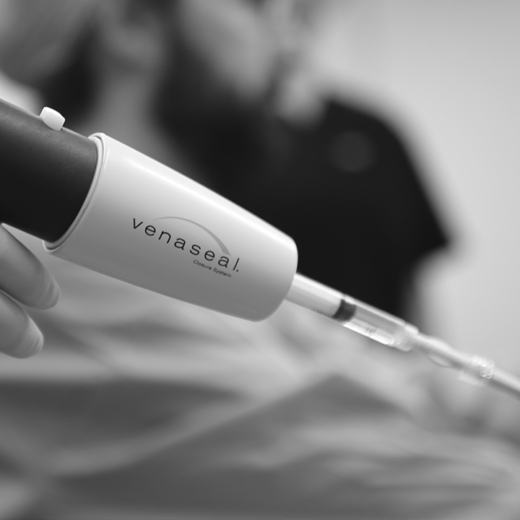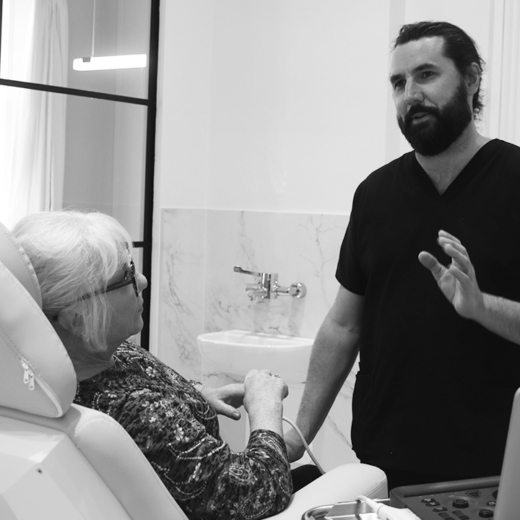McKeown Medical
167 Bath Street, Glasgow, G2 4SQ
Date posted — 2.10.24
If you’re struggling with the discomfort, swelling, or unsightly appearance of varicose veins, Radiofrequency Ablation (RFA) could be the solution you’ve been looking for. This minimally invasive procedure uses radiofrequency energy to target and close off problematic veins, providing long-lasting relief with less discomfort and downtime than traditional surgery.
In this guide, we’ll explore everything you need to know about RFA – from how it works to what you can expect during the procedure, what the recovery is, and the benefits it offers over other treatment options and the benefits some newer treatments like VenaSeal™ might have over RFA. Ultimately, there are lots of choices when it comes to treating varicose veins.

RFA is a minimally invasive medical procedure used to treat varicose veins by using radiofrequency energy to heat and close off the affected veins. It is part of a group of techniques referred to as ‘endovascular’ procedures because they involve operating inside the vein rather than outside of it in the traditional approach. RFA involves inserting a small catheter into the vein, where radiofrequency energy is delivered, causing the vein walls to contract, collapse, and eventually be absorbed by the body.
RFA was introduced in the late 1990s and early 2000s as an alternative to more invasive surgical treatments like vein stripping. Around the same time, another option known as endovenous laser ablation (EVLA) was also developed.
EVLA employs a very similar technique by delivering heat to destroy the inside of the problematic blood vessels, although it uses laser energy to deliver the heat. Both RFA and EVLA are similarly very effective, although RFA is associated with fewer side effects and is generally considered to be the superior method.
Dr Alex Vesey is our expert consultant vascular surgeon who heads up our varicose vein team. Listen to him explain the RFA treatment.

Before: Before the procedure, you’ll first have a consultation with a specialist vascular surgeon who will assess your varicose veins from taking a medical history, performing a thorough examination and an ultrasound scan to assess the anatomy of your veins. This helps determine the best veins to treat and ensures that RFA is the right option for you. On the day of the procedure, you’ll be asked to wear loose-fitting clothing and underwear that you don’t mind getting antiseptic on. You will be asked to sign an informed consent form before you go into the treatment room (a copy of this will be emailed to you in advance so you have plenty of time to read before you sign).
During: The procedure begins with the patient lying down on the treatment table and the affected leg is then cleaned and sterile drapes are applied. The doctor then makes a small incision near the knee or lower leg to insert a thin catheter into the problematic vein, guided by ultrasound imaging for precise placement. The doctor then injects a high volume of dilute anaesthetic – known as tumescent anaesthetic – along the length of the vein to be treated. As well as providing anaesthesia, this also helps to absorb the heat that is delivered to the vein during the procedure and reduces the chances of injuring surrounding tissues, like nerves. The catheter position is then rechecked and radiofrequency energy is delivered through the catheter, heating the vein walls and causing them to collapse and seal shut. This process is repeated along the length of the vein, effectively closing it off. The procedure typically takes about 30 to 60 minutes.
After: After the RFA procedure, a compression bandage or stocking is applied to the treated leg to help reduce swelling and promote healing. Most patients can stand up and walk immediately after the procedure, which is encouraged to help circulation. You may experience some discomfort, bruising, or swelling, but these symptoms usually subside within a few days. It’s generally recommended to avoid strenuous activities for about a week, but most people can return to their normal routines within a day or two. We will arrange to see you back in the clinic to assess the results, typically a few months after treatment since this is how long it takes for the veins to be reabsorbed by the body and for us to be able to assess the outcome.
Endovascular treatment with RFA offers significant benefits over traditional surgery for treating varicose veins.
One of the main advantages is its minimally invasive nature, which involves only a small incision and causes far less trauma to the surrounding tissues compared to traditional vein-stripping surgery. This leads to a quicker recovery time, allowing patients to return to their normal activities, often within a day or two, as opposed to the longer downtime required after surgery. RFA also typically results in less pain, bruising, and scarring, which improves patient satisfaction both during and after the procedure.
Additionally, because RFA uses radiofrequency energy to precisely target and close off the affected veins, it reduces the risk of complications such as nerve damage, which can be more common in traditional surgical approaches. Not everyone is suitable for RFA – which is why your initial consultation and ultrasound scan assessment are so important to make sure you get the best treatment option for your particular condition.

VenaSeal™ is a more recent innovative and effective option for the endovascular treatment of varicose veins, gaining FDA approval in 2015. VenaSeal™ uses a medical adhesive instead of heat to close off problematic veins.
The procedure involves inserting a small catheter into the vein and applying the adhesive, which bonds the vein walls together, causing the vein to seal shut and be gradually absorbed by the body. Compared to RFA, VenaSeal™ offers several advantages: it requires no heat or tumescent anaesthetic injections, which can reduce discomfort and eliminate the need for compression stockings after the procedure.
Additionally, VenaSeal™ has an even quicker recovery time – often allowing patients to resume normal activities almost immediately. While RFA remains a highly effective treatment with a proven track record, VenaSeal™ offers the same levels of effectiveness with less pain, inconvenience and downtime which is why it now accounts for around 50% of varicose vein treatment in the USA.
We are the first clinic in Scotland to introduce what is now considered to be the gold standard treatment for varicose veins.
If you’d like to find out if Radiofrequency Ablation (RFA) is the right treatment for you, the first step is to fill out our online consultation form. From there, our team will be able to arrange an initial consultation and ultrasound scan, and we can work together to create a treatment plan that is tailored to your needs.

Radiofrequency ablation (RFA) and endovenous laser ablation (EVLA) are two minimally invasive treatments used to effectively treat varicose veins, but...

When it comes to treating varicose veins, VenaSeal™ has emerged as a revolutionary option that offers a minimally invasive and...

Varicose veins are enlarged, twisted veins that often appear just under the skin, primarily in the legs and feet.
1 / 3
2 / 3
3 / 3

Radiofrequency ablation (RFA) and endovenous laser ablation (EVLA) are two minimally invasive treatments used to effectively treat varicose veins, but...

When it comes to treating varicose veins, VenaSeal™ has emerged as a revolutionary option that offers a minimally invasive and...

Varicose veins are enlarged, twisted veins that often appear just under the skin, primarily in the legs and feet.